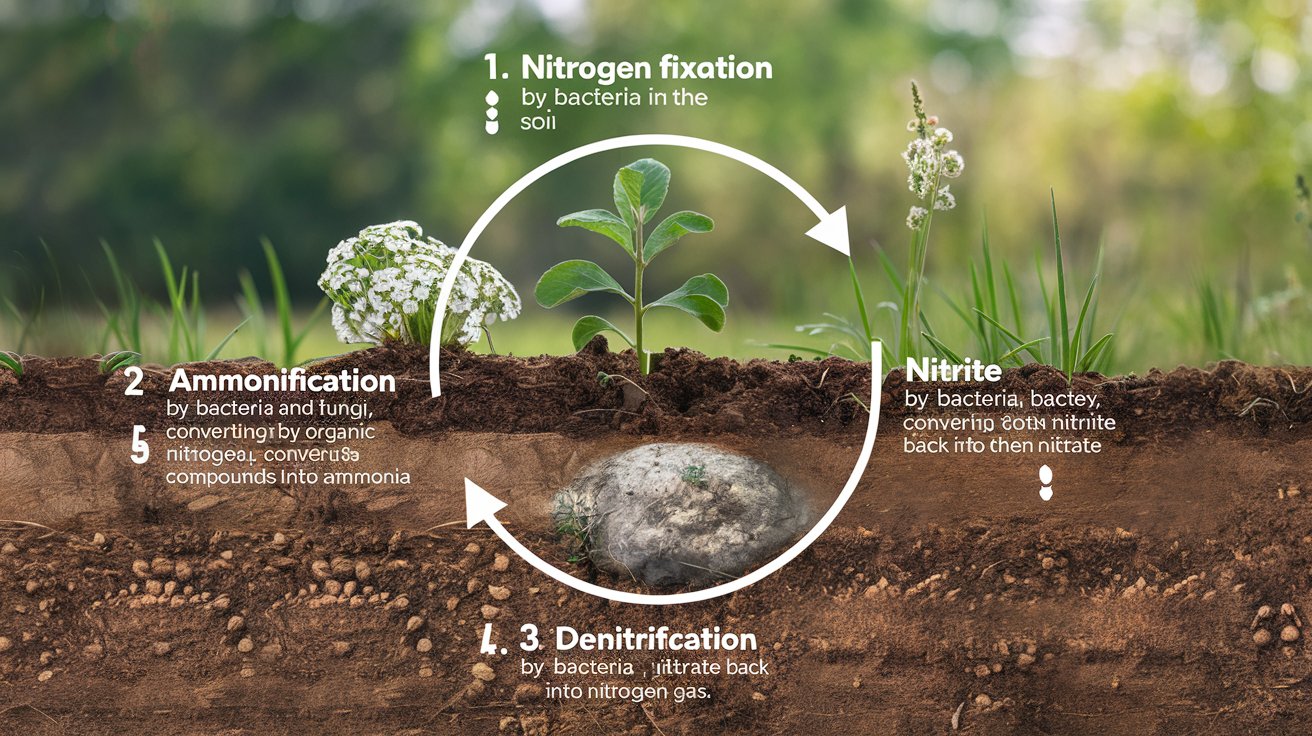
What is the nitrogen cycle? The nitrogen cycle is a natural process that moves nitrogen through the atmosphere, soil, plants, and animals. This cycle is crucial for life on Earth because nitrogen is a key component of proteins and DNA. Without it, living organisms couldn't grow or reproduce. The cycle involves several steps: nitrogen fixation, nitrification, assimilation, ammonification, and denitrification. Each step helps convert nitrogen into different forms that plants and animals can use. Understanding this cycle helps us appreciate how interconnected life is and why maintaining a balanced environment is vital. Ready to dive into some amazing facts about the nitrogen cycle? Let's get started!
What is the Nitrogen Cycle?
The nitrogen cycle is a natural process that transforms nitrogen into various chemical forms. This cycle is essential for life on Earth, as it helps plants and animals get the nitrogen they need to grow and thrive.
-
Nitrogen Makes Up 78% of Earth's Atmosphere
Most of the air we breathe is nitrogen. However, this nitrogen is in a form that most living organisms can't use directly. -
Nitrogen Fixation Converts Nitrogen Gas
Certain bacteria and lightning can convert nitrogen gas from the atmosphere into ammonia, a form that plants can use. -
Plants Absorb Nitrogen Through Roots
Plants take up nitrogen from the soil in the form of nitrates and ammonium ions, which are essential for their growth. -
Animals Get Nitrogen by Eating Plants
When animals eat plants, they consume the nitrogen stored in plant tissues. This nitrogen is then used to build proteins and other important molecules in their bodies.
The Role of Bacteria in the Nitrogen Cycle
Bacteria play a crucial role in the nitrogen cycle. They help convert nitrogen into forms that plants and animals can use.
-
Nitrogen-Fixing Bacteria Live in Soil and Roots
These bacteria form symbiotic relationships with plants, especially legumes, converting atmospheric nitrogen into ammonia. -
Nitrifying Bacteria Convert Ammonia to Nitrates
These bacteria transform ammonia into nitrites and then into nitrates, which plants can easily absorb. -
Denitrifying Bacteria Release Nitrogen Back into the Atmosphere
These bacteria convert nitrates back into nitrogen gas, completing the nitrogen cycle and releasing it back into the atmosphere.
Human Impact on the Nitrogen Cycle
Human activities have significantly altered the nitrogen cycle, often leading to environmental issues.
-
Fertilizers Add Excess Nitrogen to Soil
Using synthetic fertilizers increases the amount of nitrogen in the soil, which can lead to nutrient runoff and water pollution. -
Burning Fossil Fuels Releases Nitrogen Oxides
Combustion of fossil fuels releases nitrogen oxides into the atmosphere, contributing to air pollution and acid rain. -
Deforestation Disrupts Nitrogen Cycling
Cutting down forests can disrupt the nitrogen cycle by reducing the number of plants that absorb nitrogen from the soil.
Nitrogen Cycle in Aquatic Ecosystems
The nitrogen cycle also occurs in water bodies, playing a vital role in aquatic ecosystems.
-
Nitrogen Enters Water Through Runoff
Nitrogen from fertilizers and other sources can enter rivers, lakes, and oceans through runoff, affecting aquatic life. -
Algal Blooms Result from Excess Nitrogen
High levels of nitrogen in water can lead to algal blooms, which deplete oxygen and harm aquatic organisms. -
Aquatic Plants and Algae Absorb Nitrogen
Just like terrestrial plants, aquatic plants and algae absorb nitrogen to grow and reproduce.
Importance of the Nitrogen Cycle
Understanding the nitrogen cycle helps us appreciate its importance in maintaining life on Earth.
-
Nitrogen is Essential for DNA and Proteins
Nitrogen is a key component of amino acids, which are the building blocks of proteins, and nucleic acids like DNA and RNA. -
Nitrogen Cycle Supports Plant Growth
Without the nitrogen cycle, plants wouldn't get the nitrogen they need to grow, affecting the entire food chain. -
Helps Maintain Soil Fertility
The nitrogen cycle helps maintain soil fertility by replenishing nitrogen levels, ensuring healthy plant growth.
Challenges and Solutions
Addressing the challenges posed by human impact on the nitrogen cycle is crucial for environmental sustainability.
-
Reducing Fertilizer Use Can Mitigate Pollution
Using organic fertilizers and reducing synthetic fertilizer use can help minimize nitrogen runoff and water pollution. -
Promoting Sustainable Agriculture
Practices like crop rotation, cover cropping, and reduced tillage can help maintain a balanced nitrogen cycle in agricultural systems. -
Restoring Wetlands
Wetlands act as natural filters, removing excess nitrogen from water and helping to maintain a balanced nitrogen cycle.
Fun Facts About Nitrogen
Here are some interesting tidbits about nitrogen that you might not know.
-
Nitrogen is Colorless and Odorless
In its gaseous form, nitrogen is invisible and has no smell, making it hard to detect without scientific instruments. -
Liquid Nitrogen is Extremely Cold
At -196°C (-321°F), liquid nitrogen is used in various scientific and industrial applications, including cryogenics and food preservation. -
Nitrogen is Used in Explosives
Compounds like nitroglycerin and TNT contain nitrogen, making them highly explosive and useful in mining and construction.
Nitrogen Cycle's Impact on Life
The nitrogen cycle plays a crucial role in sustaining life on Earth. It ensures that nitrogen, an essential element for all living organisms, is continuously recycled and made available in forms that can be used by plants and animals. Without this cycle, ecosystems would collapse, and life as we know it wouldn't exist.
Understanding the nitrogen cycle helps us appreciate the delicate balance of nature and the importance of maintaining healthy ecosystems. Human activities, like agriculture and industrial processes, can disrupt this balance, leading to environmental issues such as pollution and climate change. By being aware of these impacts, we can take steps to minimize our footprint and protect the natural processes that support life.
In essence, the nitrogen cycle is a testament to the interconnectedness of all living things and the environment. Let's cherish and protect this vital process for future generations.
Was this page helpful?
Our commitment to delivering trustworthy and engaging content is at the heart of what we do. Each fact on our site is contributed by real users like you, bringing a wealth of diverse insights and information. To ensure the highest standards of accuracy and reliability, our dedicated editors meticulously review each submission. This process guarantees that the facts we share are not only fascinating but also credible. Trust in our commitment to quality and authenticity as you explore and learn with us.


